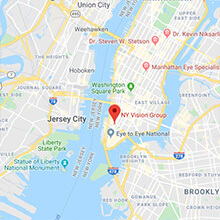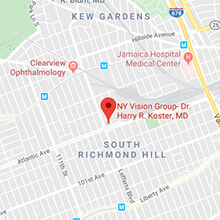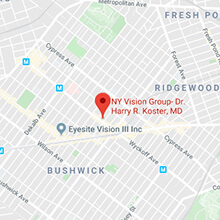Premium Lens Implants offer a new alternative for cataract patients seeking a broader range of vision than the vision provided by traditional “mono-focal” lens implants. Recent technological breakthroughs have led to the development of several exciting new options for cataract patients, including the PanOptix® and Vivity® lens implants which can provide a significantly broader range of vision, greatly reduce dependence on glasses, and correct for presbyopia (the loss of ability to refocus near vision, typically noticed after age 45). Other alternatives are the Tecnis Symfony and ReSTOR lenses.
All of these lenses are called “accommodating” or “multifocal” intraocular lenses because they allow the eye to accommodate a greater range of vision (from near to far vision) in contrast to the traditional “mono-focal” implant, which typically can only correct for distance vision. In addition, the Acrysof Toric lens implant can help reduce or eliminate astigmatism after cataract surgery. NY Vision Group is pleased to offer these alternatives to our patients in New York City, Brooklyn, and Queens, particularly since Dr. Koster was the first eye surgeon to implant the PanOptix and Vivity lenses in New York City.
Multifocal Lenses – PanOptix, Vivity, ReSTOR, Tecnis Symfony
The PanOptix Lens
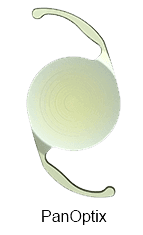
The PanOptix lens is the first trifocal lens approved by the FDA for use in the United States. This presbyopia-correcting lens is engineered to provide: clear distance vision; enhanced intermediate vision; and excellent near vision without reading glasses or bifocals. The PanOptix lens is a unique technological innovation that is particularly well suited for patients who want to enhance their vision for clear complete focus and who would like to have a chance of eliminating glasses.
How Does PanOptix Work?
As we perform daily activities such as reading, watching television, or working on the computer, our eyes are constantly changing focus through a process known as “accommodation”. This task is performed by the lens of the eye, which changes shape, or accommodates, to allow the eye to focus at different distances. As we age, however, our lens loses the ability to change shape and thus our accommodating ability diminishes, causing us to become more dependent on bifocals or reading glasses. The PanOptix IOL is a foldable IOL lens that was designed to overcome this dependence, with 26 different refractive rings around the device, giving patients a seamless range of vision and helping correct for the condition known as presbyopia.
Clinical Studies
During PanOptix’s clinical studies, patients experienced lifestyle enhancement through quality vision and greater freedom from reading glasses and bifocals. According to a clinical study of patients who received the PanOptix, 80.5% of the participants reported never wearing glasses within the past seven days and 11.4% reported that they rarely used them.
This same clinical study showed that:
- 99 percent of patients in the clinical study were so satisfied with their vision that they would have the PanOptix® lens implanted again if given the choice.
- 98 percent of patients in the clinical study would recommend the PanOptix® to family and friends.
In another clinical study of 243 cataract patients, half of whom received the PanOptix, the average best-corrected vision after 6 months was 20/20 for each group. For intermediate vision, however, PanOptix patients averaged 20/25 compared to 20/40 in the control group. Even more extraordinary, the clear vision for near distance correction for the PanOptix patients was 20/25 compared to 20/63 for the control group.
Typically, there is an adjustment period for PanOptix and all multifocal implant lenses, as a patient’s brain adapts to the broader range of vision. Also, as is possible with other multifocal lenses, some patients report halos or glare around lights after their surgery. Patients who drive at night have reported visual disturbances such as rings around lights. However, only 5% of patients receiving the PanOptix implant had noticeable nighttime visual disturbances, and most of those reported decreased symptoms over time. Most patients reported that their ability to see near, intermediate and far distances outweighed any visual side effects.
The PanOptix lens comes from Alcon, a world leader in cataract surgery. It is made of the same material as Alcon’s widely-used AcrySof intraocular lens, of which more than 125 million have been implanted worldwide. A Toric version of the lens is available to address astigmatism.
The Vivity Extended Depth of Focus Lens
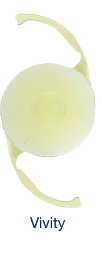
The Vivity lens is another presbyopia-correcting, premium implant developed by Alcon that can restore a broad range of vision with increased independence from glasses or contact lenses. Vivity uses Alcon’s new, non-diffractive technology called X-Wave. This proprietary technology uses all available light to create a continuous, extended range of vision. Other diffractive multifocal lenses split the wavefront into multiple separate focal points. With Vivity, there are no rings or light-splitting. Instead light rays are stretched or shifted to create a continuous extended focal range, delivering distance, intermediate, and some degree of near vision for patients.
The X-Wave technology also offers protection against damaging UV rays and filters blue lights. Some patients who receive other multifocal lenses complain about visual disturbances such as halos, starbursts, and glare. However, patients with the Vivity lens are reporting lower visual disturbances (similar to a mono-focal lens). This is a distinct advantage for patients looking to drive at night.
How Does Vivity Work?
Alcon’s X-Wave non-diffractive technology uses two smooth surface transition elements on the anterior surface of the IOL that work simultaneously to create a continuous, extended range of vision rather than separate focal points. Recent clinical trials found Vivity provides very good quality of vision at distance and intermediate ranges in bright and dim light, and functional near vision.
Clinical Studies
During Vivity’s clinical studies, patients experienced lifestyle enhancement through quality vision and greater freedom from reading glasses and bifocals. Without glasses, 94% percent of patients reported good or very good vision at distances and 92% reported good or very good vision at arm’s length. Additionally, patients using Vivity reported such low levels of starbursts, halos, and glares that Vivity’s visual disturbance profile is comparable to a mono-focal lens.
As with the PanOptix and other multifocals, typically there is an adjustment period for Vivity, as a patient’s brain adjusts to the new range of vision.
The Vivity is FDA approved and is made of the same material as Alcon’s widely-used AcrySof intraocular lens, of which more than 125 million have been implanted worldwide. A Toric version of the lens is available to address astigmatism.
Comparison of PanOptix and Vivity IOLs
| PanOptix | Vivity | |
| Distance Vision | Excellent | Excellent |
| Intermediate | Excellent | Excellent |
| Near Vision | Excellent | Good |
| Rings around Lights | Yes | No |
The ReSTOR and Tecnis Symfony Lens
The ReSTOR Lens

The AcrySof ReSTOR and Tecnis Symfony multifocal lenses are premium implants that can restore a range of vision with increased independence from glasses or contact lenses. Although the technology used in the PanOptix and the Vivity IOLs is slightly more advanced, both the ReSTOR and Tecnis Symfony provide excellent results. For most patients, the ReSTOR IOL delivers the excellent near and far vision and good intermediate vision without reading glasses or bifocals. In fact with this increase in vision quality, ReSTOR patients would be able to pass the visual acuity part of the driver’s license exam in most states (without glasses!).
The AcrySof ReSTOR lens is a unique technological innovation which is particularly well suited for patients who would like to have a chance of eliminating glasses. The ReSTOR lens has been FDA-approved for cataracts, with or without presbyopia since March 2005 and was approved for use in Europe two years prior to that time.
For most patients, the ReSTOR IOL delivers a significantly broader range of vision, without reading glasses or bifocals, than the vision provided by mono-focal lenses. In fact, 84% of patients who received the ReSTOR lens demonstrated uncorrected vision without glasses of 20/25, which would enable them to pass the visual acuity part of the driver’s license exam in most states (without glasses!). The AcrySof ReSTOR lens is a unique technological innovation which is particularly well suited for patients who would like to have a chance of eliminating glasses. The ReSTOR lens has been FDA-approved for cataracts, with or without presbyopia since March 2005 and was approved for use in Europe two years prior to that time.
Extended Depth of Focus – Tecnis Symfony

Another premium lens option is the Tecnis Symfony IOL. The Tecnis Symfony is an Extended Depth of Focus (EDOF) Presbyopia-Correcting IOL designed to provide continuous, high-quality vision at any distance. It is intended to provide high-quality vision from near to far and points in between and may reduce the frequency of wearing glasses. The Tecnis Symfony was approved by the FDA for cataract use in 2016.
With Tecnis Symfony IOLS, patients may be able to comfortably enjoy low-light activities such as taking a walk at dusk, going to the movies or even driving at night. Some patients do experience a loss of sharpness, which may become worse under poor visibility conditions such as dim light or fog. In addition, as with any surgical procedures, inherent risks exist with all multifocal implants, and a patient’s results cannot be guaranteed. During your visit to NY Vision Group, the risks, benefits and alternatives will be discussed with you.

Toric Lenses-Toric
The Acrysof Toric lens implant differs from the multifocal implants describe above in that it was specifically designed for patients who have a significant amount of astigmatism. In the past, when patients with significant astigmatism had cataract surgery, they would still require glasses for near and distance vision (because of their astigmatism). The design of the Acrysof Toric lens makes it possible to reduce or eliminate astigmatism and improve uncorrected distance vision. As with the other premium multifocal implants described above, there is an additional cost for this lens implant. However, we strive to make all of these lenses affordable through our various payment options.
Who is a Candidate for Premium Implants?
Virtually everyone who has cataracts and/or presbyopia (loss of ability to refocus near vision, noticed after age 45) and is in good general health may be a candidate for refractive lens exchange and/or cataract surgery with the PanOptix, Vivity, ReSTOR, or Tecnis Symfony implant. If a patient has significant astigmatism, they may be a candidate for a Toric lens implant.
Additionally, a person who has a normal eye exam and is dependent on reading glasses or bifocals may be a candidate. Although these premium multifocal lenses are a breakthrough technology initially approved for cataract patients with or without presbyopia, it is not necessary to need cataract surgery to qualify for the Tecnis multifocal lens, just a desire to reduce or eliminate your dependence on glasses. Also, individuals with more extreme levels of nearsightedness or farsightedness may be better candidates for lens replacement surgery with the Tecnis multifocal lens than laser vision correction. After a thorough examination, we will be able to better advise you if you qualify for these multifocal implants.
What are the Risks?
Lens replacement surgery is identical to cataract surgery and results in safe and successful outcomes in approximately 98% of eyes treated. Like any surgical procedure, there are risks. During your visit to NY Vision Group the risks, benefits, and surgical alternatives will be discussed with you. Fortunately, cataract surgery is one of the most common and safest surgical procedures performed in the U.S. today with 3 million procedures performed annually.
Some visual effects associated with multifocal IOLs may be expected because of the superposition of focused and unfocused images. These may include a perception of halos/glare around lights under nighttime conditions. It is expected that, in a small percentage of patients, the observation of such phenomena will be annoying and may be perceived as a hindrance, particularly in low illumination conditions. On rare occasions, these visual effects may be significant enough that the patient will request the removal of the multifocal IOL. Additionally, individuals who are planning on receiving a multifocal lens may need an additional procedure to “fine-tune” their vision or may need to wear glasses for distance, intermediate and/or near vision to obtain optimal visual acuity. The difference from basic mono-focal lenses is that most people with multifocal lenses will not be as dependent on these supplemental vision aids to function normally.
Contact Us
Please contact our New York office if you are interested in the PanOptix, Vivity, ReSTOR, Tecnis Symfony or Toric multifocal IOLs.

